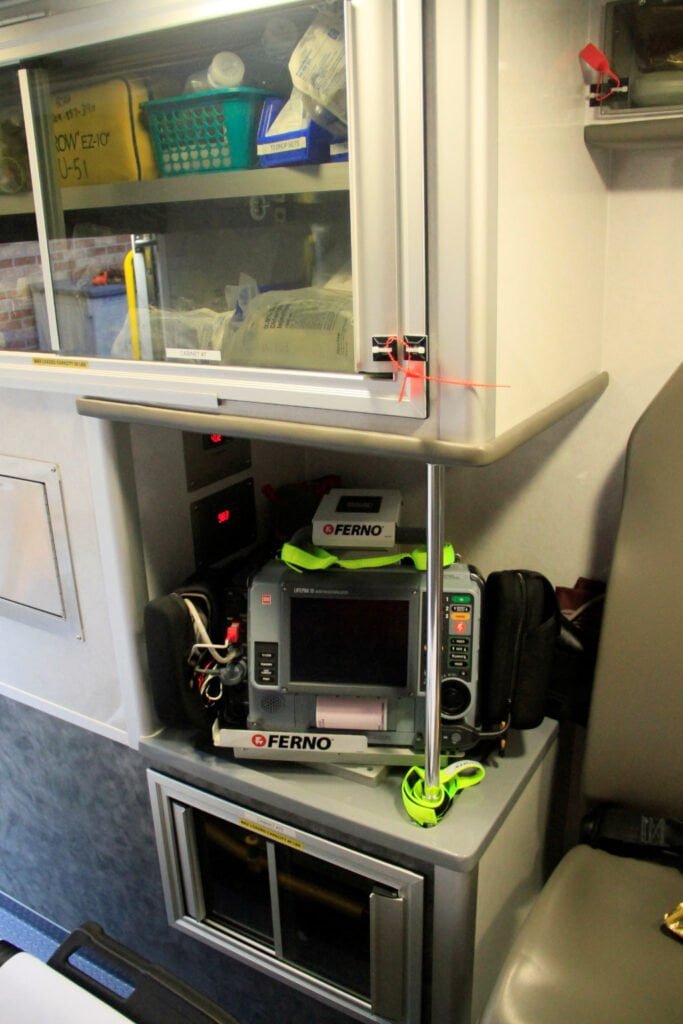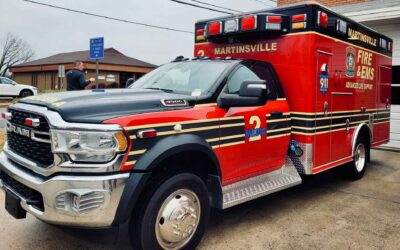
Wheeled Coach built this Type 1 Critical Care Transport/Advanced Life Support ambulance for Boone County (WV) Ambulance Authority on a Ford F-450 4×4 chassis with a club cab. (Photos courtesy of Boone County Ambulance Authority.)
By Alan M. Petrillo
The Boone County (WV) Ambulance Authority has taken delivery on a Wheeled Coach Type 1 Critical Care Transport/Advanced Life Support (CCT/ALS) ambulance that was funded through an Assistance to Firefighters Grant (AFG) the agency received last year.
Bryan S. Justice, Boone County Ambulance Authority’s director, says his agency covers 21,000 residents in 503 square miles and runs 10,000 calls a year with five ALS ambulances from three stations staffed by 39 full-time paramedics and EMTs. “We do a lot of patient transfers when the weather doesn’t allow flying patients by helicopter,” Justice points out, “so we wanted to get into the critical care transport program to help our local hospital get patients transferred instead of waiting for a helicopter or CCT transfer by an ambulance from another county.”

Boone County’s new ambulance is fitted with a Stryker Power-LOAD system and Power-PRO XT cot.
Justice says Boone County wrote and received an AFG grant of $246,000, which paid for 90 percent of the new rig. “We talked with our paramedics and EMTs and had them help us design the new truck,” he says. “We designed the ambulance on a 2021 Ford F-450 4×4 chassis with a club cab so a third medic can ride in relative comfort on a long transport because sometimes we have three hour round trips.”
Related
Pasco County (FL) Fire Rescue Goes to Road Rescue for Larger Cab Type 1 Ambulance
North Andover (MA) Fire Department Adds Horton Type 1 Ambulance to Its Fleet
Road Rescue Builds Type 3 Ambulance for Bay Ambulance (MI)
Casey Walker, vice president of ambulance sales for Atlantic Emergency Solutions, who sold the Wheeled Coach Type 1 to Boone County, says the CCT/ALS ambulance has a wheelbase of 192 inches, an overall length of 26 feet 8 inches, an overall height of 9-feet, 2-inches, and a 95-inch wide and 153-inch long patient module with a door-forward design on the curb side of the rig.

The driver’s position in the cab of the new rig.
“Boone County went with a critical care layout inside the patient box where they have a captain’s chair instead of a squad bench on the curb side of the box, and the door forward design allows for a custom workstation to the front of the captain’s chair,” Walker points out. “All seating positions are protected by REV Ambulance Group’s Per4Max four-point seat belt harnesses. They also have a Mermaid Medi-Kool refrigeration system back there, a dual climate system that can heat or cool medications to the appropriate temperature.”

The new Wheeled Coach rig carries six Baxter IV pumps.

The oxygen hook-up location on the left interior of the module.
Justice notes that the new rig has a Liquid Spring rear suspension that gives a smoother ride for both patients and medics in the back, six Baxter IV pumps, a Lifepak 15 defibrillator and cardiac monitor, a ventilator and a Zico oxygen bottle lift in the left side compartment behind the cab. “We’re always concerned about potential back injuries, so we put in the Zico lift, which helps mitigate back injuries, and also a Stryker Power-LOAD system and Power-PRO XT cot in the new ambulance,” he says. “We also received a $380,000 AFG grant this year to install Stryker Power-LOAD systems in the rest of our ambulances, which have always used the Power-PRO XT cot.”

The Boone County ambulance is outfitted with a Lifepak 15 defibrillator and cardiac monitor in a Ferno mount.
Justice adds that the new Wheeled Coach is fitted with a Cool Bar emergency warning light and air conditioning system, a GPS system, cameras on the sides and rear of the vehicle, a Whelen Howler siren, a Hi Viz Fire Tech 35-inch LED light on the front of the box, and Fire Research Corp. LED scene lights on the sides of the module.
ALAN M. PETRILLO is a Tucson, Ariz.-based journalist, the author of three novels and five non-fiction books, and a member of the Fire Apparatus & Emergency Equipment editorial advisory board. He served 22 years with Verdoy (NY) Fire Department, including the position of chief.




